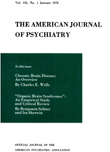A TWELVE-YEAR FOLLOW-UP OF NEW YORK NARCOTIC ADDICTS: I. THE RELATION OF TREATMENT TO OUTCOME
Abstract
A group of 100 male New York City addicts admitted to the USPHS Hospital at Lexington, Ky., between August 1952 and January 1953 were followed until 1965. Ninety-four percent were successfully followed for at least ten years; 75 percent of the patients were volunteers. The majority of the patients had begun the illegal use of drugs in late adolescence and had been considered antisocial—although they were not imprisoned—prior to Lexington. Most of the patients had been severely addicted prior to Lexington, and after Lexington 90 percent of the sample relapsed to use of narcotics and over 90 percent received jail sentences. Nevertheless, at time of last contact, 46 percent of the sample were off drugs and in the community. Thirty percent had been abstinent for the last 3 to 12 years.
The length of short-term abstinence after Lexington appeared to be correlated with the length of hospitalization. More dramatic, however, were the findings that 96 percent of all addicts who sought voluntary hospitalization for their addiction relapsed within a year and that 67 percent of those who received at least nine months of imprisonment and a year of parole were abstinent for a year or more. The most significant variable in determining abstinence in the confirmed addict appeared to be the presence or absence of constructive but enforced compulsory supervision. The writer believes that both prison sentences without provision for parole and purely voluntary programs are often contraindicated in the treatment of urban addiction.
Access content
To read the fulltext, please use one of the options below to sign in or purchase access.- Personal login
- Institutional Login
- Sign in via OpenAthens
- Register for access
-
Please login/register if you wish to pair your device and check access availability.
Not a subscriber?
PsychiatryOnline subscription options offer access to the DSM-5 library, books, journals, CME, and patient resources. This all-in-one virtual library provides psychiatrists and mental health professionals with key resources for diagnosis, treatment, research, and professional development.
Need more help? PsychiatryOnline Customer Service may be reached by emailing [email protected] or by calling 800-368-5777 (in the U.S.) or 703-907-7322 (outside the U.S.).



